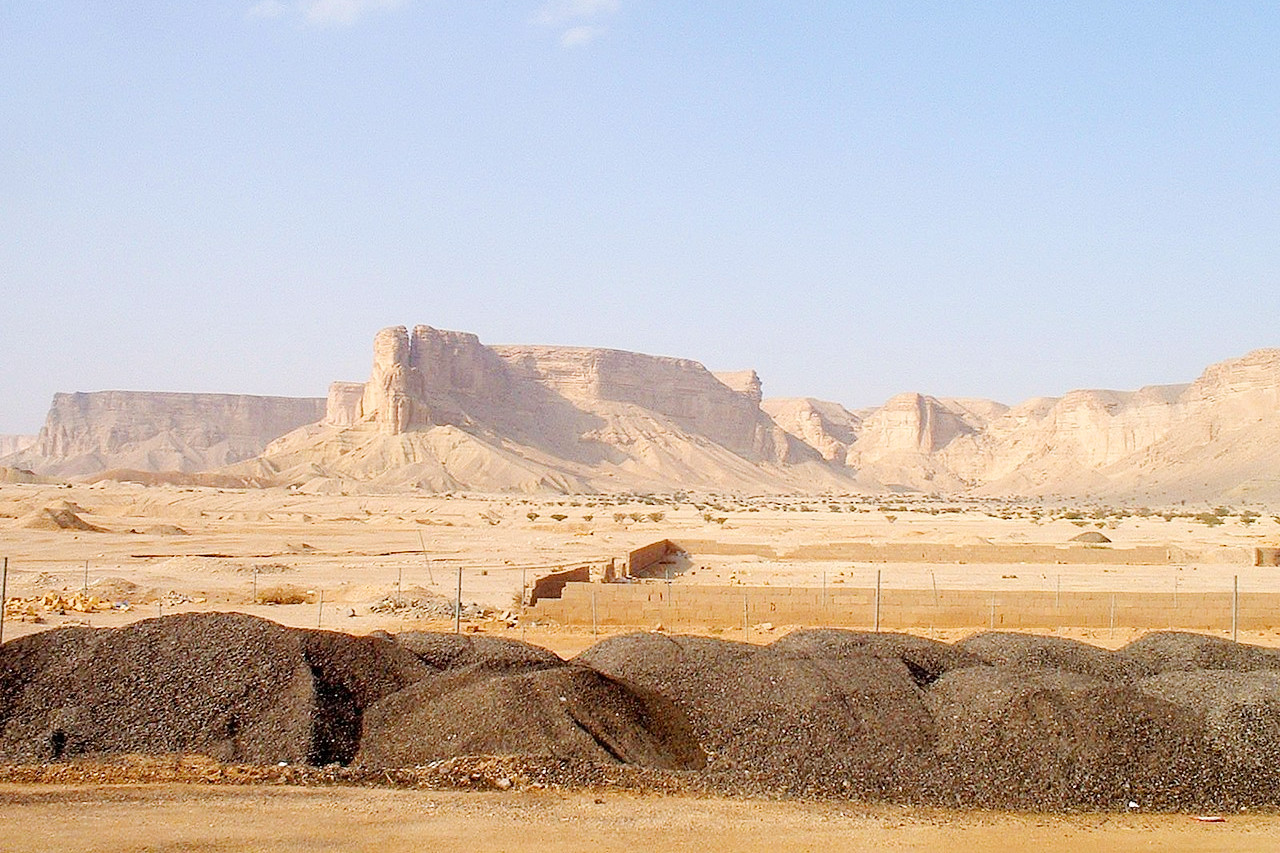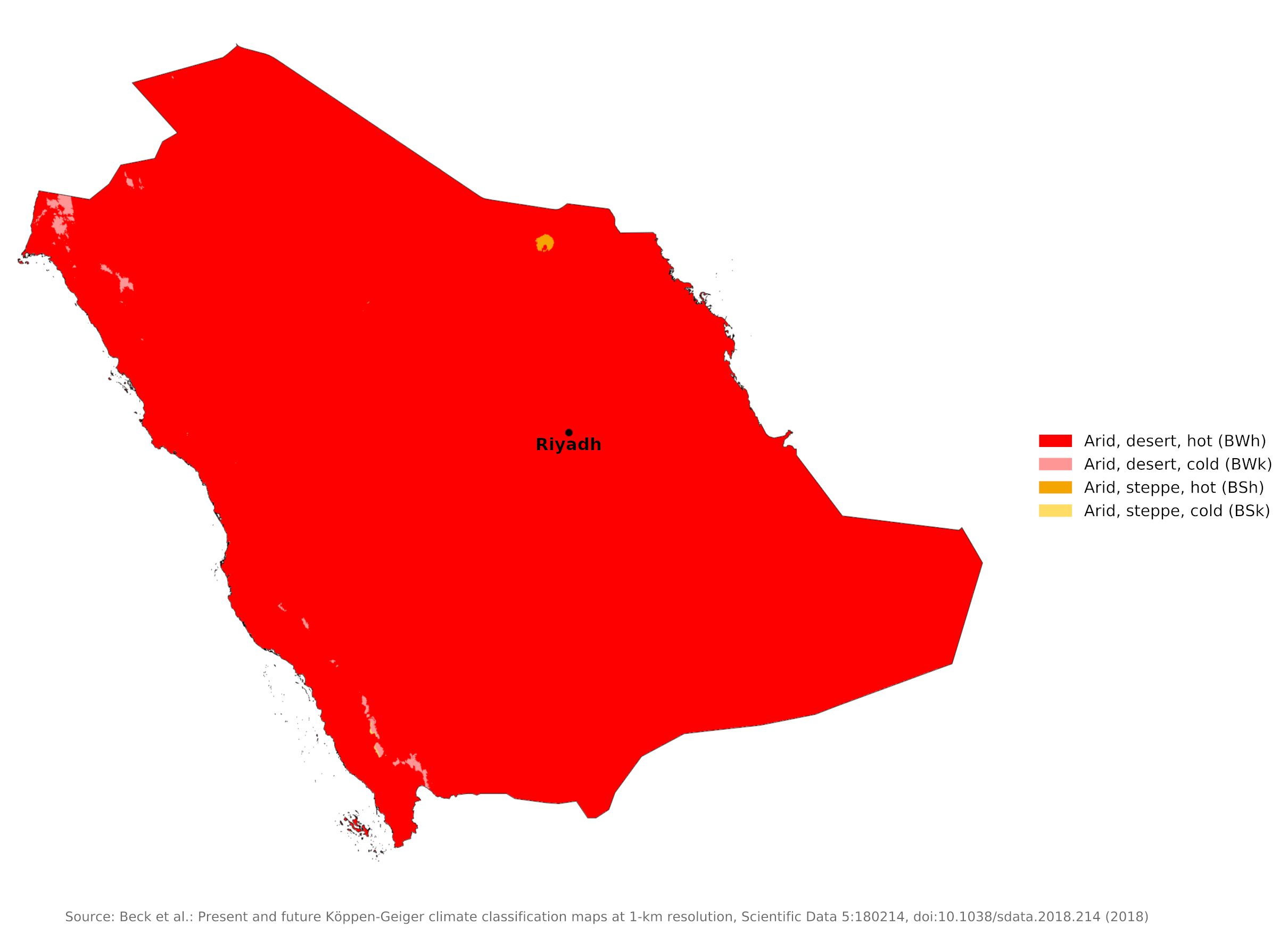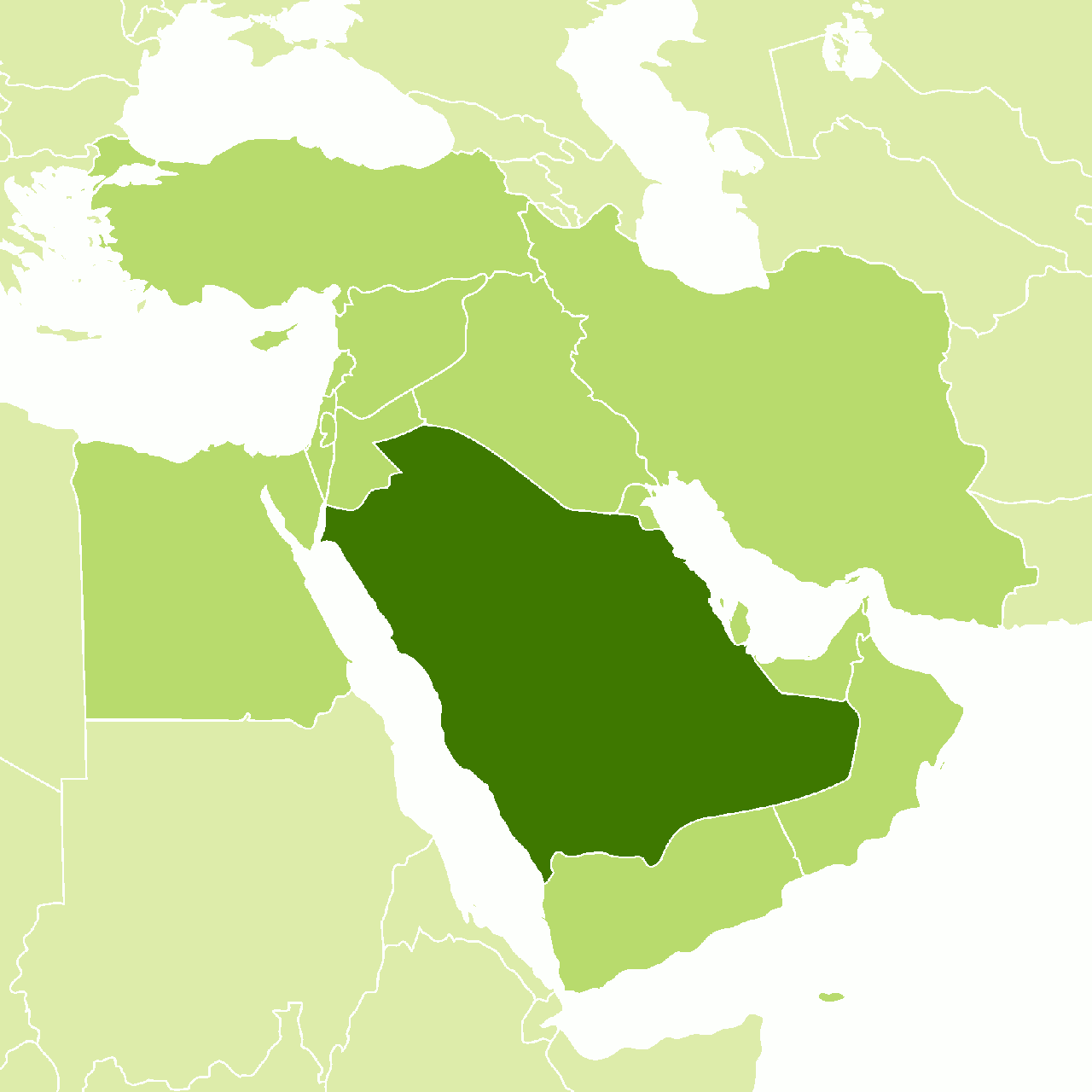The Climate of
Saudi Arabia
 Tuwaik escarpment, southwest of Riyadh
Tuwaik escarpment, southwest of Riyadh
Climate Map
 Climate map of Saudi Arabia
Climate map of Saudi Arabia
What is the climate of Saudi Arabia like?
Saudi Arabia comprises the greater part of the Arabian peninsula. It is a large country, most of which is desert. It is bordered on the north by Jordan and Iraq. In the east of Saudi Arabia there is a short coastline on the Gulf but there are land borders with the small Gulf states of Kuwait, Qatar, and the United Arab Emirates. There is a long land border with Oman and with Yemen on the south. In the west it has a long coastline on the Red Sea.
Most of Saudi Arabia is desert with a low and unreliable rainfall. Where the rainfall is greater, this is a result of higher mountainous areas where the lower temperatures produce some relief from the fierce, dry summer heat. Most of the peninsula consists of a rolling plateau of low to medium elevation which slopes northeastwards from a higher mountainous rim on the west to a low plain on the shores of the Gulf.
Saudi Arabia has a desert climate characterized by extreme heat during the day, an abrupt drop in temperature at night, and slight, erratic rainfall. The desert climate of Saudi Arabia is generally very dry and very hot. Saudi Arabia's climate is more temperate from October to April, with evening temperatures between 16°C and 21°C (61°F and 70°F). Inland and in the higher mountains of north-western Saudi Arabia, winter temperatures occasionally drop enough to cause frost and snow. Winter nights in the desert are distinctly cool. Two major climate extremes are felt between the coastal lands and the interior.
Coast
In coastal regions along the Red Sea and the Persian Gulf, the desert temperature is moderated by the proximity of these large bodies of water. Temperatures seldom rise above 38°C (100°F), but humidity is high, usually more than 85 percent and frequently 100 percent for extended periods. This combination produces a hot mists during the day and a warm fog at night.
The prevailing winds are from the north. A southerly wind brings with it a rise in temperature and humidity, along with a storm in the gulf area known as a kauf. In late spring and early summer, a strong north-west wind, the shamal, blows. Any strong wind is likely to kick up dust and sand to create dust storms and sandstorms that can contribute to the uncomfortable conditions, whether it's a cold gust of winter or a scorching dry wind in summer.
Interior
A hot desert climate prevails in the interior. The daytime humidity falls fairly low, but the average summer daytime temperature is 45°C (113°F), and this is one of the few areas in the world where temperatures exceeding 50°C (122°F) are not uncommon. The heat becomes intense shortly after sunrise and lasts until sunset, followed by comparatively cool nights. In the winter, the temperature seldom drops below 0°C, but the almost total absence of humidity and the high wind-chill factor make a bitterly cold atmosphere. In the spring and autumn, temperatures average 29°C (84°F).
Rainfall
The average annual rainfall is only about 90 millimeters (3.5 inches). Most rain falls from November to May. The east coast is known for heavy fog, and humidity there can reach 90 percent. Between 250 and 500 millimeters (10 and 20 inches) of rain fall in the mountainous ʿAsir region in the southwest of Saudi Arabia, which has a summer monsoon.
Elsewhere rainfall is low and unreliable: under 200 millimeters (8 inches) and often less than 100 millimeters (4 inches). North of Jeddah and Riyadh, precipitation is almost limited to November to April or May and is caused by weak disturbances from the Mediterranean Sea or North Africa. An entire year's rainfall may consist of one or two torrential outbursts that flood the wadis and then rapidly disappear into the soil to be trapped above the layers of impervious rock. This is sufficient in many places to sustain a degree of plantlife.
Whole regions may not experience rainfall for several years. Much of the Rub' al Khali (the "Empty Quarter" in the south) is considered "hyper-arid" as it often does not rain for more than twelve consecutive months.
Sunshine
Sunshine is very high in most parts of Arabia, ranging from six to eight hours a day in winter to twelve to thirteen in summer. Any visitor to Saudi Arabia should be prepared for very hot conditions between May and October. From the very hot, dry interior to the sweltering Gulf and Red Sea coasts, heat exhaustion and heat exhaustion can pose a threat, particularly to newcomers and those not taking sensible precautions.
| Climate data for Riyadh (1985-2010) | |||||||||||||
|---|---|---|---|---|---|---|---|---|---|---|---|---|---|
| Month | Jan | Feb | Mar | Apr | May | Jun | Jul | Aug | Sep | Oct | Nov | Dec | Year |
| Average high °C (°F) | 20.2 (68.4) | 23.4 (74.1) | 27.7 (81.9) | 33.4 (92.1) | 39.4 (102.9) | 42.5 (108.5) | 43.5 (110.3) | 43.6 (110.5) | 40.4 (104.7) | 35.3 (95.5) | 27.8 (82.0) | 22.2 (72.0) | 33.3 (91.9) |
| Daily mean °C (°F) | 14.4 (57.9) | 17.3 (63.1) | 21.4 (70.5) | 26.9 (80.4) | 32.9 (91.2) | 35.7 (96.3) | 36.8 (98.2) | 36.7 (98.1) | 33.5 (92.3) | 28.4 (83.1) | 21.5 (70.7) | 16.3 (61.3) | 26.8 (80.3) |
| Average low °C (°F) | 9.0 (48.2) | 11.2 (52.2) | 15.2 (59.4) | 20.4 (68.7) | 25.9 (78.6) | 28.0 (82.4) | 29.3 (84.7) | 29.2 (84.6) | 25.9 (78.6) | 21.2 (70.2) | 15.5 (59.9) | 10.6 (51.1) | 20.1 (68.2) |
| Average precipitation mm (inches) | 12.5 (0.49) | 8.0 (0.31) | 24.0 (0.94) | 28.0 (1.10) | 4.9 (0.19) | 3.0 (0.12) | 3.7 (0.15) | 4.0 (0.16) | 0.1 (0.00) | 0.8 (0.03) | 8.7 (0.34) | 14.6 (0.57) | 112.3 (4.4) |
| Source: Jeddah Regional Climate Centre South West Asia | |||||||||||||
References
- E. A. Pearce, Charles Gordon Smith, (1990) The Hutchinson World Weather Guide, John Murray Press. ISBN 1859863426
- Timothy L. Gall, (ed.), (2003), Worldmark Encyclopedia of the Nations, Eleventh Edition, Thomson Gale
- Federal Research Division, Library of Congress, (1993), Saudi Arabia: a country study. Claitor's Pub. Division. ISBN 0844407917
- Hugh Chisholm, (ed.), (1911), Encyclopædia Britannica, Eleventh edition, Cambridge University Press
The Climate of
Saudi Arabia

In summary:
Saudi Arabia has a desert climate which is generally very dry and very hot. Day and night temperatures vary greatly. In the interior, daytime temperatures from May to September can rise above 45°C (113°F). The climate is more moderate from October through April, with evening temperatures between 16°C and 21°C (61°F and 70°F).
Average annual rainfall is about 90 mm (3.5 in), with most rain falling from November to May, and in most places rainfall is low and unreliable often falling as one or two torrential outbursts.